Cutworms
Noctuidae
Appearance
Some ground-dwelling caterpillars of various owl moths appear as pests and are very similar in appearance and damage pattern: in addition to the winter sowing owl(Agrotis segetum) and the ypsilon owl(Agrotis ipsilon), members of the genera Scotia, Euxoa and Noctua should be mentioned. One of the most economically important owl butterflies in Austria is the winter sowing owl, also known as the sowing owl. It is described below as a representative of the other species.
The moths of the winter owl are coloured in various shades of brown and have a wingspan of around 4 cm. The forewings are elongated and have a grey spot in the middle (kidney patch). Typically, they have their forewings folded over the lighter coloured hindwings in a roof shape when at rest.
The caterpillars have a grey-brown base colour and light brown dorsal stripes. They have two pairs of abdominal legs when young, later four. The fully developed caterpillars reach a length of about 4 cm.
The spherical eggs , about 0.5 mm in size, are laid singly or in small groups on their food plants and are initially yellowish, later brownish in colour.
The pupa is about 2 cm long, 5 mm thick and can only be distinguished from other butterfly pupae, which are also found in soil cocoons, by experts.
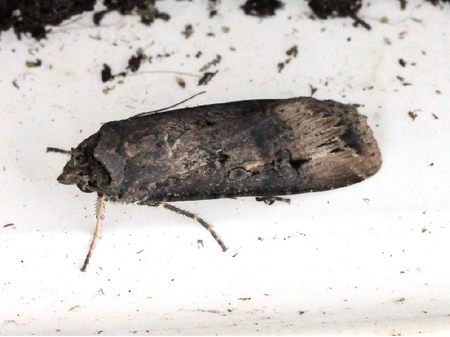
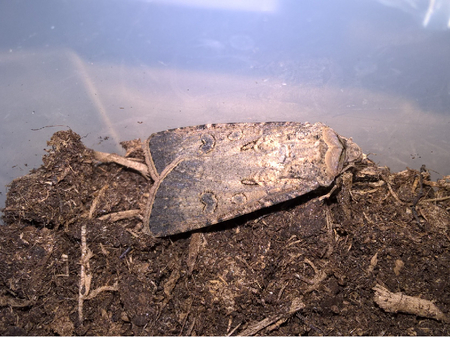

Biology
After overwintering as caterpillars in the soil, the soil caterpillars appear on the surface in spring as soon as the soil temperature exceeds 10 °C. However, they no longer feed. However, they no longer feed, but build a soil cocoon at a shallow depth in the soil, in which the metamorphosis to pupa takes place. The finished owl moths hatch from this at the end of May/beginning of June. They fly on dark, windless nights when the air temperature is at least 15 °C at dusk.
After mating, numerous eggs are laid on various low-growing plants. The caterpillars initially feed above ground on the leaves, leaving feeding holes. Young caterpillars in the second instar appear around the time of flowering of the winter lime tree. From the third larval stage onwards, they change their habits: during the day they stay close to the plants in the soil and only go in search of food at night. Younger plants are often eaten.
After rain or artificial irrigation, however, the caterpillars can also be found on the soil surface during the day. Older larvae eat a lot, migrating from already destroyed to undamaged plants. After three to four weeks of feeding, the caterpillars, which are now up to 4 cm long, pupate in a small burrow lined with spider silk (soil cocoon). After a short pupal period, the moths hatch in August. The caterpillars that develop from this generation of moths spend the winter in the soil in an almost fully-grown state.
Damage symptoms
The caterpillars feed on roots, rhizomes, stems and leaves of numerous cultivated plants. Young plants eaten just above the ground are particularly characteristic. The rest of the plant lies next to the stump as if felled.
In the case of root vegetables, pit-shaped feeding sites appear.
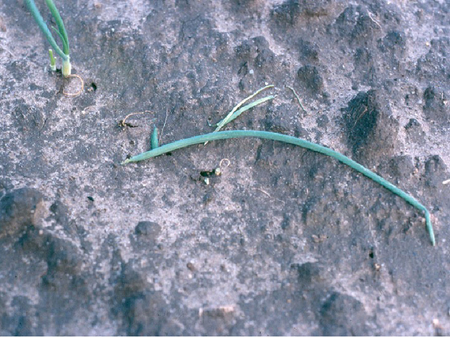
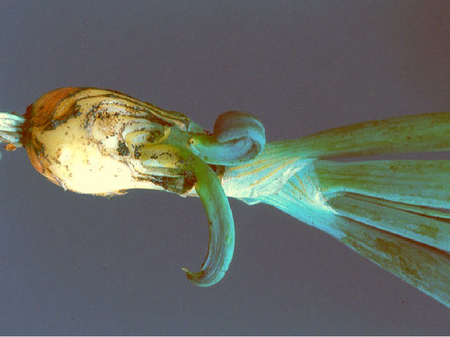

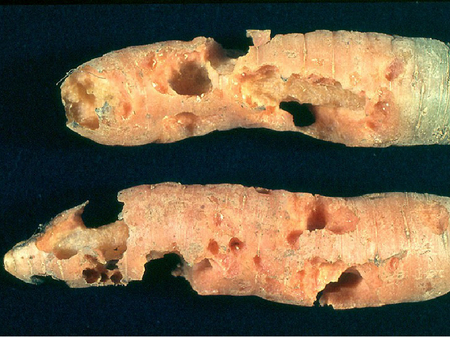
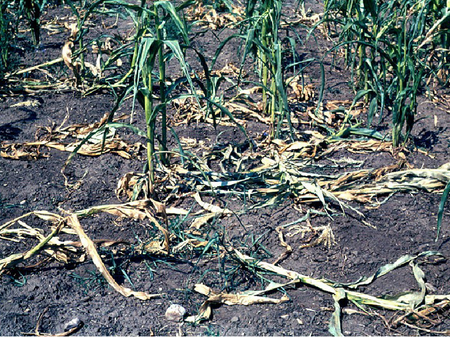
Host plants
While the winter sowing moth occurs mainly on field and vegetable crops grown or planted in late summer, the ypsilon moth mainly attacks vegetable crops in early summer.
In addition to many flowering plants (asters, carnations, chrysanthemums, ...), mainly vegetable plants (lettuce, beans, peas, spinach, peppers, cabbage, salsify, celery, radish, onions, asparagus, beetroot) and field crops (potatoes, maize, winter cereals, winter rape, ...) are infested.
The caterpillars of the house moth(Noctua pronuba), on the other hand, gnaw on the young buds of vines in spring.
Propagation and transmission
Winter Seed Owls fly well and can travel long distances to find suitable habitat. Mass reproductions can be observed yearly, especially in dry areas. According to practical experience, severe damage is only to be expected if dry-warm weather prevails at the time of egg laying and larval development.
Economic importance
While the first generation of caterpillars of the winter sowing owl is only weakly expressed in early summer, the second generation appears in late summer on almost all crops and can cause very severe damage. When they occur en masse, ground caterpillars can cause not only significant reductions in quality due to pitting and cavity feeding, but also considerable quantitative yield losses in emerging crops, for example.
Prevention and control
- Protection and promotion of the habitats of natural enemies such as birds, hedgehogs, toads, moles, shrews, but also predatory ground beetles, parasitic caterpillar flies and parasitic wasps(Eutanyacra picta).
- Earth caterpillars are sometimes also attacked by insect pathogenic viruses and microsporidia (spore animals), which reduce the vitality of the caterpillars.
- Chickens in allotments decimate caterpillars - but it is essential to ensure that they are compatible with the crop.
- Artificial irrigation decimates the young larvae.
- Intensive tillage disrupts the development cycle of the soil caterpillars.
- Carry out early and regular inspections of the plants for window, hole and edge feeding in order to be able to take control measures against young caterpillars.
- Thorough weed control can reduce egg laying.
- The use of Bacillus thringiensis (Ssp. aizawai) preparations is only useful against young larvae. However, the infestation is usually only noticed when the larvae are already large.
- The use of entomopathogenic nematodes(Steinernema carpocapsae) is possible.
- The use of plant protection products (see list of plant protection products authorised in Austria) is best applied against the young larvae and in the evening.
Specialized information
Further literature
Bionet brochure: Owl Caterpillars - Owl Butterflies, Lukas Weninger, Roswitha Six (FiBL Austria).
Last updated: 10.03.2025
automatically translated